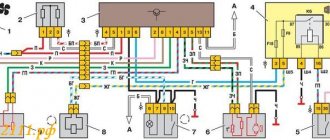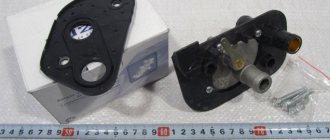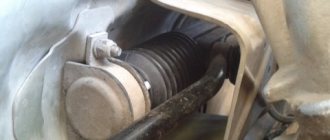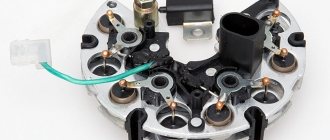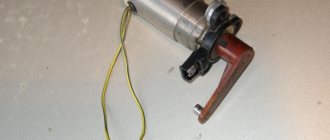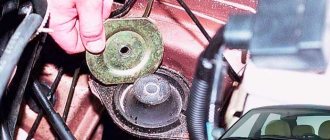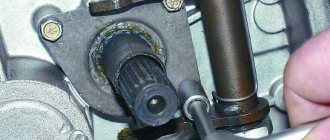Modernization
With a little modification, you can significantly improve the Kirzhach headlights with your own hands and make their glow brighter.
First, the headlight must be removed, then disassembled in the following sequence:
- To remove glass from Kirzhach, use a hairdryer - you need to heat the sealant, then use a sharp knife to separate the glass;
- Remove the reflective pad;
- The modernization will only affect the low beam units, so unscrew them;
- And then you have a choice: with Kirzhach you can either move the lens towards the reflector by 10 millimeters, or grind off the modular ring, making it shorter. This will help improve the luminous flux of the Kirzhach headlights, raise it and make it wider.
The interior lighting does not turn off.
#1 maxks90
- Users
- 205 messages
- City: opposite Butyrka
- Car: VAZ21134
- Top
#2 Sir YareG
thinks he is telling the “Truth”)) Fail
- City: Railway-City
- Interests: Depeche Mode & Cars!
- Auto: Behind The Wheel.
Post edited by Sir YareG: April 11, 2010 - 07:28
- Top
#3 Reizer899
- City: Krasnoyarsk City
- Interests: Auto
- Car: Mercedes G
The light gradually goes out due to the relay, if memory serves, otherwise look at the limit switches, or better yet, immediately change them to new ones.
- Top
#4 maxks90
- City: opposite Butyrka
- Car: VAZ21134
- Top
#5 Vint
I know what I'm saying
- City: Kursk
- Auto: 2112 T
Changes memory. Smooth dimming of the light is ensured by the immobilizer. APS-4 in this case.
- Top
#6 Fuser
- City: Moscow, Southern Administrative District
- Auto: 2115 1.5 16V
- Top
#7 maxks90
- City: opposite Butyrka
- Car: VAZ21134
- Top
#8 alpine-2
- City: Kazan
- Car: VAZ 21093
- Top
Number of users reading this topic: 0
0 users, 0 guests, 0 hidden users
What types of reflectors are there?
Different car models have excellent reflectors.
The choice of one type or another depends on a number of factors:
The last point includes ordinary lighting devices, as well as halogen devices.
On modern cars you can find 4 types of reflectors.
In addition to the structural features of the reflective lens, reflectors differ in the material they are made of.
They can be made from:
Unlike thermoplastic, thermoset plastic has greater resistance to prolonged exposure to elevated temperatures. Low weight, as well as sufficient strength, are a clear advantage of this material over glass and metal.
Other malfunctions affecting the illumination of the rear lights
The reversing lights may not light due to a faulty switch. To troubleshoot, you need to do the following:
- disconnect the connector;
- unscrew the switch with a 21 key;
- remove the switch and replace it with a new one.
A malfunction of the car's lights may be caused by problems with the hydraulic corrector. With its help, you can change the angle at which the headlights are tilted (this is due to the different load levels of the car). The hydraulic corrector consists of a master cylinder, which is mounted on the dashboard, actuator cylinders of the headlights and connection tubes. It cannot be disassembled and cannot be repaired. The assembly part should be replaced. Removal and installation of the main cylinder of the headlight hydraulic corrector occurs in stages:
- remove the handle and cylinder lining by prying it off with a screwdriver;
- unscrew the nut with a 22" head;
- remove the hydraulic corrector.
The trunk light may also need replacing. In this case you need:
- Disconnect the cable and terminal of the negative battery;
- disconnect the rear light from the block with wires by opening the trunk lid;
- press the fastener parts and remove the holder with lamps from the flashlight body;
- unfasten the lamp by unscrewing two nuts;
- loosen the three nuts that secure the decorative trim of the luggage lid and unscrew the nut closest to the lamp;
- lift the cover and remove the lamp;
- The new lamp is installed in the opposite order to that described above.
Many cars of the VAZ family, including the VAZ 2110, have a problem that affects safety and also causes a lot of trouble for drivers. The rear light board is a thin strip with conductive tracks. You have to change this tape quite often, and with it the burnt out light bulbs. You can use the option of inserting iron cartridges from the VAZ 2101. So, to do this, you need to:
- remove and disassemble the rear lights, removing the board and the tape from them;
- buy single cartridges for stops and dimensions;
- purchase copper wire with a cross-section of 2.5 mm, connectors, M3 bolts;
- mark the places for the cartridges and drill them, finishing the holes with a file;
- to modify the cartridges for clearance and brake lights, turn the tip terminals 180 degrees;
- completely cut out the cartridges from the turn signals;
- secure the cartridges to the plastic with bolts and nuts;
- connect all the cartridges, laying the pluses on the turn signal, stops and dimensions;
- extend the connector block and install everything on the car.
Luggage compartment
Since the luggage compartment can be considered part of the car interior, it is necessary to clarify that there is also a flashlight here. It can be used to illuminate the contents of the trunk. In some situations, his work is irreplaceable. To access this mechanism, you must perform the following actions:
- The exterior lighting in the car is completely turned off.
- To release the lantern from its location, you must use a tool. For this purpose, you can use a simple screwdriver. She needs to remove the flashlight from the interior trim.
Note: To dismantle the lampshade, it is necessary to disconnect it from the two power wires. In order to eliminate the possibility of a short circuit when using this lighting device, it is necessary to insulate its connections with special adhesive tape or other sealant.
- The lamp is removed by pressing on the connecting elements. It occurs by analogy with the previous description of removing lamps from the socket.
- To turn on a new lamp, it is necessary to install it. It is pressed into the cartridge mount until it stops.
- To install the flashlight in its original place, you need to insert one end of the lampshade into the connector of the casing, and apply slight pressure on the other. A slight click will indicate that the light is fully connected to the connector in the luggage compartment.
Adjustment algorithm
We sequentially perform the following:
- Cover the right headlight with cardboard or other material that does not transmit light;
- Turn the hydraulic corrector to the first position (I);
- Open the hood, find the screws used for adjustment, and turn them. At the same time, if the left headlight is adjusted, then it will be correct if its light at the top reaches the line N, and at the bottom – P;
- Having adjusted one, the adjustment of the other begins, closing the previous one.
Remember, if the headlights shine too low, they need to be raised, otherwise you may not notice the pedestrian in time, especially if there is slush on the street and he is wearing black clothes. If the light is set high, that is, you deign to raise them high, oncoming drivers will not thank you because you will blind them. Therefore, do-it-yourself adjustment on the VAZ must be done very carefully.
How to remove the headlights yourself and adjust them if the device has defects?
In some cases, the VAZ 2110 headlights cannot be adjusted. This is due to damage to the hydraulic corrector or defects on the reflectors or glass. In this case, you can try to disassemble the unit and replace unusable parts.
How to disassemble the headlight?
Sequence of disassembling the VAZ 2110 headlight:
- Remove the part from the car, remove all lamps from the housing.
- Heat the glass evenly with a hair dryer, melting the sealant layer. Separate the lens from the headlight housing using a flat object. When disassembling a Bosch headlight, you need to unfasten the glass mounting brackets.
- Unscrew the three reflector mounting points.
- Remove the corrector spring through the hole for installing the actuator.
- Remove the reflector from the housing by turning the angle adjusters.
- Wash the headlight components, replace faulty parts and reassemble the assembly. The sealant used is a silicone compound used for installing car windows.
Features of removing and adjusting the headlight
Headlight removal procedure:
- Disconnect the battery terminal.
- Remove the upper decorative radiator grille, which is mounted on two bolts.
- Remove the power supply plugs for the headlight.
- Remove the actuators of the correctors. The part is secured with a latch and a rotary lock.
- Unscrew the three bolts securing the headlight and recess it a little deeper.
- Slide the decorative strip (“eyelash”) and remove it from its seat on the bumper. To facilitate dismantling, loosen the upper bumper mount located between the headlights.
- Unscrew the fourth mounting point of the headlight and remove it from the socket.
- Install a new part (the procedure is performed in reverse order).
A removed VAZ 2110 headlight can be cleaned of dirt and repaired; the design does not provide for any adjustments.
Repair of ignition switch VAZ 2110
The entire lock as a whole is not very expensive, although most of the breakdowns can be fixed quite easily; to do this you will need to dismantle it, disassemble it and then replace the parts that are faulty.
To replace the contact group of the VAZ 2110 ignition switch, you will first need to release the latches so that some of the parts can be freely removed from the body. After this you can easily install a new group. You will not be able to mix up the sides for installation, because the part simply will not fit on the other side.
Instructions for replacing the contact group:
- First you need to disconnect the plug that goes into the backlight. Using a screwdriver, you need to bend the 3 latches that are fixed by the plastic cover, then you can remove it from the lock.
- To gain access to the contact group, you need to bend 2 more latches.
- Then you need to inspect the light guide plate and check if there is a black coating and other deposits. If you find any, you can remove these defects with fine sandpaper. If after this there is no result, then you can replace it.
- Under the light guide plate there are 3 more plates, which are also prone to oxidation, as a result of which the contact group may malfunction. They can also be cleaned with sandpaper.
If you just want to do preventive maintenance for the contact group, then once every six months it is enough to lubricate the contacts with penetrating or graphite lubricant, which would effectively counteract oxide. Choosing a lubricant is a very serious and complex procedure. When buying, you should not take the cheapest one. I would like to note that there are several types of lubricants: light (not thick) and heavy (thick). Some car enthusiasts use aerosol penetrating lubricant “liquid key” or WD-40.
A replacement of the lock cylinder is carried out only if the car has been stolen or the key simply does not turn well in the lock. To change it, you will have to remove the protective plate from the outside of the part using a special slotted screwdriver. After dismantling, all you have to do is install a new part and periodically lubricate it with lubricant to extend the service life of the part (it is recommended to lubricate 2 times a year, before and after the autumn-winter season).
If the microswitch is broken, then you need to unscrew the screws from the housing, remove the rod and press the lock. After this, the switch can be easily removed and a new one installed in its place. Everything is put back into place, respectively, in the reverse order.
The backlight lamp is generally the easiest to replace; to do this, you need to remove the power connector, then you can carefully remove it using pliers.
To replace the ignition switch, you need to know some nuances.
Installation of EUR
Required Tools
Let's say you purchased an EUR kit - it could be from a VAZ 2110 or from another model, for example, from a Priora. Prepare the following tools:
- Drill together with a metal drill.
- Set of screwdrivers, grinder.
- Long ruler.
All is ready? Let's move on to installation.
Step-by-step instruction
- You need to remove the standard terminal from the block and place it in the block on the harness.
We find the standard drive, which is attached to the block. A free terminal must be installed in its place. Now the wire can be placed between the fasteners. We take out the standard terminal and place the terminal from the EUR kit there - Now we take a screwdriver in our hands and carefully remove the steering column housing, and then dismantle the lock and switches.
We need to remove the steering rack; to do this, unscrew the bolt that holds it. Unscrew the fastening screw and remove the part - Take the new and old shaft. Compare their lengths, since we will have to adjust the shaft together with the plate in the future. Don't forget to write down your results.
- We need to adjust the shaft, this should be done on a special machine. It is better to perform this step with the masters, and then return to independent work again.
- As for the plate, here you need to use a drill.
Make sure that the EUR plate matches the hydraulic booster plate. If necessary, trim the corners and place a spacer between the plate and the tens body. Drill additional holes in the plate - Now you can try to install the electric amplifier along with the rack and plate.
If the standard bolt does not fit, then take a smaller mount. The next step is to install the center part of the switch. Installing the central part into the panel - Now we stretch two wires from the interior of the VAZ 2110 to the battery, this can be done through the left wing.
Next, you will need to dismantle the washer reservoir; behind it you will see a copper wire. We move to the safety block and find the wiring there that goes under the hood. The wire must be placed there, as a result it will come out in the left wing. Attach the wires to it, and then pull it all the way into the space under the hood. Pull out the copper wire from the hood space - We dismantle the upper part of the instrument panel (speedometers) and find the red block.
We take the wires coming from the power steering and move them to the space under the dashboard. We need to find the orange wire - disconnect it and put it on the block that came with the EUR. Having found the end with the terminal, place it in place of the standard wire. Connect the orange wire to the EUR terminal - We repeat the procedure with the gray wire. We return to the wires that we pulled out through the wires: we connect the pink plus to the plus, and the black to the minus.
- Done, all that remains is to put the steering wheel and casing back in place.
Adjustment
After assembly, you will need to straighten the steering wheel if it is installed crooked. Separately install the sensor that came with the EUR. If the column casing is cracked, it is better to immediately replace it with a good one. There may be gaps between the front panel and the casing - they must be removed.
Panel device
A lot of car interior lighting is located in the dashboard. The process of replacing it is one of the most difficult. To carry out work on the dashboard, you must:
- To carry out work with electrical wiring, you should be safe and disconnect the negative terminal from the battery.
- The steering column covers are decorative. They need to be separated from the dashboard.
- The car steering wheel is removed. The horn plate remains unchanged.
- The switches that are located under the steering wheel must be separated from the vehicle.
- When disconnecting them, you will need to disconnect the wires and their connection element.
- The headlight range control has a regulator (a specific position switch). It needs to be dismantled.
- The next step is to unscrew the nut, which is located under this regulator.
- The mounting block is opened.
- This opens access to the location of the fuses (they can blow out, and therefore it is necessary to check their serviceability) and the relay block. It may be enough to replace them. Here you need to unscrew the screw securing the bracket. It is located on the left side.
- The wiring block is disconnected from the ignition system. It is also necessary to unscrew the screw that secures the bracket.
- The tips, two in number, are disconnected from the brake signal switch.
- The console trim has two screws. You need to remove them from the car.
- The console bracket is released.
- The screw securing the instrument panel and air duct must be unscrewed.
- The panel wire mount is disconnected from the rest of the power supply system.
- The immobilizer sensor must be disconnected, namely its wires.
- Similar actions occur on the right side of the panel.
- The nut securing the bracket is removed.
- The wires coming from the cigarette lighter are disconnected.
- The same operation must be done with the fog lamp wires.
- The glove box has a bolt at the top. It must be removed from the connector.
- Both screws of the lower fastening of the instrument panel are unscrewed.
- The seal is removed from the front left pillar.
- Plastic holders are dismantled.
- The same technology is applied to the right pillar.
- The ventilation grilles are removed.
- There are two bolts underneath that need to be unscrewed and removed.
- The dashboard extends slightly, about 10 centimeters, into the interior.
- Once the instrument panel remains in the cabin, you need to disconnect the remaining wires near the left door pillar and next to the steering column.
After completing these steps, you can safely begin replacing sensors, backlights and other components of the dashboard. The assembly process occurs in the opposite order of disassembly. The corresponding video and photo will help you do everything right with your own hands. Of course, if you do everything as the instructions require. Parts, light bulbs, fuses, etc. can be purchased at a special store. The price for them is not too high. You may have to spend time selecting parts. Their diversity can lead to a lot of different situations. Sometimes, parts simply do not fit a particular mechanism. The best option would be to use an old part as an example.
The interior light flashes when the turn signal is turned on.
#1 CHILL99
- Car: Opel Vectra B 1999
- @Mention
Hi all. I have a problem on the Vectra B. When I turn on the turn signal (in any direction), all the lights in the cabin start blinking (dashboard lights, interior lighting lamps, in general, everything that lights up). Everything flashes in time with the turn signal. And if you turn on the emergency lights, it all intensifies several times. Can anyone tell me what the problem is? Thanks in advance.
- Top
- Answer
- Quote
#2 Anthony_87
Experienced Opel Driver
- City: Moscow, Zhukovsky
- Car: OVC GTS 07 Z18XER 5MT
- @Mention
- Top
- Answer
- Quote
#3 CHILL99
- Car: Opel Vectra B 1999
- @Mention
- Top
- Answer
- Quote
#4 Anthony_87
Experienced Opel Driver
- City: Moscow, Zhukovsky
- Car: OVC GTS 07 Z18XER 5MT
- @Mention
strange electricians - just hang a voltmeter on the battery and see how the voltage changes when you turn on the consumers and turn signals - if it sags below about 13 (I don’t know what the norm is for Vectra B) - it means the generator does not give a full charge and there are options - voltage regulator, worn out brushes or the gene itself is already dying - but the latter is unlikely
- Top
- Answer
- Quote
#5 CHILL99
- Car: Opel Vectra B 1999
- @Mention
strange electricians - just hang a voltmeter on the battery and see how the voltage changes when you turn on the consumers and turn signals - if it sags below about 13 (I don’t know what the norm is for Vectra B) - it means the generator does not give a full charge and there are options - voltage regulator, worn out brushes or the gene itself is already dying - but the latter is unlikely
I forgot to specify the generator; I changed it in September, the old one was damaged. And what’s funny is that this happened in both the old and the new.
- Top
- Answer
- Quote
#6 Anthony_87
Experienced Opel Driver
- City: Moscow, Zhukovsky
- Car: OVC GTS 07 Z18XER 5MT
- @Mention
- Top
- Answer
- Quote
#7 CHILL99
- Car: Opel Vectra B 1999
- @Mention
- Top
- Answer
- Quote
#8 Anthony_87
Experienced Opel Driver
- City: Moscow, Zhukovsky
- Car: OVC GTS 07 Z18XER 5MT
- @Mention
- Top
- Answer
- Quote
#9 CHILL99
- Car: Opel Vectra B 1999
- @Mention
I'll try to measure it today. I'll write tomorrow.
- Top
- Answer
- Quote
#10 CHILL99
- Car: Opel Vectra B 1999
- @Mention
I tried it on today. Here are the clarifications: When the engine is not running 12.6 V When the motorcycle is not working and the emergency lights are on 12.49-12.53 (presses within these limits) When the engine is running 14.8 When the engine is running and first one then the second turn signal is on (separately ) - 14.78-14.79 When the engine is running and the emergency lights are on - 14.75-14.77.
Improved high beam
There is also a way to modify the high beams, allowing you to use the standard high beams and DRLs, depending on the time of day. Thanks to the DRL function, you can make your car visible during the day, reduce the current consumption of headlights and increase the life of incandescent lamps. Refinement involves installing a 12V halogen lamp. In this case, the light is directed into the eyes of oncoming drivers, and not into the asphalt, as with low-beam headlights. However, the light does not dazzle and makes the car stand out on the road. The DRL function can be done using high beams, which will shine at only 33 percent of the power and act as daytime running lights. Thus, the normal functioning of the high beam headlights is complemented by an additional mode of sequential activation of 2 high beam lamps. When the DRL button is turned off, the high beam operates in simple mode. The process of implementing such a function is performed in the following order:
- First, a wire is pulled from the interior to the right headlight.
- The wire is connected to the relay terminal (87), then the cover of the high beam headlight module is opened.
- The ground wire is pulled out and cut in the middle.
- The end of the wire coming from the headlight is insulated, and a wire is soldered to the second end going to the high beam lamp, which is laid through the headlight vent.
Note. It is better to pull the wire from the outside of the headlight, using tweezers, through the low beam hole. It is necessary to ensure that the new wire inside the headlight does not touch the headlight sockets. This wire acts as a new ground for the high beam lamp.
- The wire is then connected to the relay pin (30) and the 5 pin relay pin (85) is connected to the green wire in the headlight connector.
- The relay terminals (86 and 87) are connected to ground.
Note. It is better to run a separate wire to the side member stud, where the masses of headlights, fog lights and conductors also converge.
- The connections are then insulated with electrical tape and heat shrink tubing.
- The wire in the passenger compartment fuse box is connected to the fog lamp connector, that is, a button, fuse and relay from the fog lamp circuit are used.
Note. You can make a separate switch in any convenient place.
Power is taken from +12 V after the ignition switch (red-blue wire). Then the daylight will be turned off with the ignition turned off. It is mandatory to install a 5A fuse. OK it's all over Now. With my own hands I managed to not only replace the high beam lamp, but also significantly improve the light performance of the headlights. The instructions given in this article tell you how to act in a situation where there are problems with the high beam headlights, just perfect. And it is noteworthy that by learning how to change headlight lamps yourself and modernize them, you can save a lot of money, because the price of lamps is not expensive, and you do not need to pay repairmen for services.
Sources
- https://master-informa.ru/remont-nissan/poleznye-sovety/20287-zamena-lamp-blizhnego-sveta-vaz-2110-svoimi-rukami-masteravaza
- https://masteravaza.ru/vneshnee-osveshhenie-avtomobilya/fary-elektroprovodka-i-elektrooborudovanie/zamena-lamp-dalnego-sveta-vaz-2110-468
Replacing a light bulb in the cabin
As you know, the interior light is located in a special lampshade. To remove it, you must:
- insert a screwdriver into the slot of the lampshade;
- there will be visible wires that should be disconnected;
- next you will need to bend the antennae of the cartridge;
- remove it together with the lamp (holder).
Note. Now you should inspect the light bulb. You can even check it, because it also happens that it is in order, but the cartridge or wiring is faulty.
- make sure that the light bulb is in good working order;
- replace it with a new one;
- The lampshade is assembled in the reverse order.
Headlight adjustment
To correctly adjust the headlights of a VAZ-2110 car, the instructions recommend contacting a service station equipped with a special stand or mobile device for adjusting the direction and quality of the light flux. The device shows not only the direction of light, but also the quality of light distribution of the reflector and glass diffuser, which allows us to judge the suitability of the headlight for further use. Experiments have shown that within 4-5 years of operation, all elements of the headlight become unusable and are unable to create the correct direction and the required level of illumination and must be replaced.
Lensed headlights
Separate light first appeared on the VAZ-2103 model, but here the Tolyatti people went further. The headlights from one of the two suppliers used low beam lenses. By the way, many still say that modern Ladas also need them. But the point is not in the lenses, but in how the headlights are made and how they shine. Yes, dozens had lenses, but they shined so poorly that they became legendary in a negative sense. And then the VAZ team, apparently, rightly reasoned that efficiency comes first, and aesthetics second, which is why the Kalina, Priora and Vesta headlights were made with conventional reflectors. But they shine great.
Exterior lighting, brake and reverse lights, interior and trunk lighting
The front side light lamps are located in the headlights (see the “Headlights” section), the rear lamps are located in the external rear lights (on the car’s fenders). The brake and reverse lamps are located in the inner rear lights on the trunk lid. (Removing the brake light switch, see “Removing the vacuum booster and brake pedal assembly”). The license plate lights are located on the bumper.
The parking light is on when the exterior light switch is pressed. The side light and brake light lamps are powered through relay K1 for monitoring the health of the lamps in the mounting block. If any of the lamps burns out or the contact in the socket or supply circuit is broken, the corresponding indicator lights up in the control unit. If there is no lamp control relay, there must be jumpers instead, otherwise the lamps will not light.
The license plate lamps turn on simultaneously with the exterior lighting, but are connected bypassing the control relay, so their serviceability is not diagnosed.
The glove box illumination lamp is turned on when the ignition is turned on by a switch under the box lid.
On-board control system
In terms of the number of instrument scales, the “ten” is inferior to the already mentioned “three”, but it is ahead in the number of alarms. And instead of placing them all in the instrument cluster, some of them were brought to a dedicated area on the center console. There were indicators for faulty lamps of side lights and brake lights, unfastened driver's seat belt, worn brake pads, low level of coolant and washer fluid, low level of engine oil and open doors, and not one for all four, as is usually the case, but individually on every door. Subsequent models no longer had such richness. It’s a pity, because many would not refuse these alarms.
The VAZ-2110 family, together with the Priora, was produced for 23 years. And since the car was so popular with people, there is no doubt that they will not forget to celebrate the next anniversaries either.
vote
Article rating
How to disassemble and improve headlights on a VAZ-2110: tuning
Tuning the headlights on your VAZ-2110 with your own hands will not be difficult if you approach this procedure wisely. In this case, the result will please the owner, and his previously unattractive car will look much more modern. The main thing in this matter is to strictly follow the instructions in order to avoid mistakes.
This brand, as a rule, has optics of such types as “Kirzhach” and “Bosch”. The procedure for dismantling old headlights consists of the following steps:
- First you need to disconnect the blocks with wires and remove the upper part from the radiator grille. To do this, take a key of 10.
- After this, you need to remove the boxes with the wires connected to the direction indicators. Immediately after this, the headlight hydraulic corrector is pulled out using a special latch.
- Next, you need to unscrew the headlight mounting bolts and remove the edge from the place where it engages with the wing.
- After completing this work, the headlight of the car is carefully pulled out.
We looked at the procedure for removing a Bosch headlight. Now let’s find out how to remove the Kirzhach optics. This work consists of the following stages:
A flat screwdriver is inserted into the corner of the headlight, as well as a utility knife, which is used to cut off the sealant. If you can’t cut with this tool, you can use a hair dryer; then we proceed to remove the reflector
This is done like this: unscrew 3 bolts around the perimeter and unfasten 4 latches; then the headlights are carefully removed.
The situation is different with the modernization of optics
It is very important to understand what is suitable in a particular case and what is not. Let's try to understand this issue
Replacing the VAZ-2110 stove light bulb with your own hands
If the heater light on your vehicle stops lighting, this may indicate a failure of the incandescent lamp or problems with the electrical wiring.
The work of replacing the heater control bulb is not particularly difficult, so each car owner can do it independently. To do this, you must initially purchase new panel light bulbs. Often, to improve the illumination of the controller, LED lamps are installed instead of conventional lamps, which are characterized by a higher quality light flow and a longer service life.
Before starting work, be sure to switch all controls to the inoperative state. This is necessary so that when connecting the heating element the contacts do not burn out due to a heavy load. In order to get to the light source, it is necessary to dismantle the heater control unit. Initially, remove the plastic plugs that are located on the sides of the stove regulator. In those places where there were plugs, there are latches. To remove the control panel, you need to insert your fingers into the side holes, press the latches and remove the vehicle heating control unit.
Dismantling must be done very carefully so as not to damage the wiring. Shortened wires are suitable for the heater switches. You need to pull the block towards you a little and disconnect the plug
Next, very carefully, using a screwdriver, remove the switch handles. After this, you need to open the four latches on the sides of the control panel, remove the product cover and remove the transparent light diffuser
Now all that remains is to replace the failed light bulb with a new light source. Before assembling everything into its regular places, first check the operation of the installed lighting element. To do this, connect the control unit to the plug in the car and turn on the ignition. If the lamp does not light, then the problem may be in the heater wiring, or more precisely, in the contacts of the lamp socket. To identify the cause, you need to have a tester and basic knowledge of electronics. If there is no contact in the socket, it will also have to be replaced by purchasing a new part at the market or at a car store. Replacement is made by soldering the product instead of the old lamp socket. Be sure to insulate the soldering points after troubleshooting so as not to cause a short circuit in the future.
After fixing the problem, you can install a new light bulb, regular or LED. Check the functioning of the lighting element again. Then you can reassemble the stove in reverse order.
Injection "ten"
In addition to the wiring that is provided for the VAZ 2110 - carburetor, "ten" - injector, it is also equipped with a number of fuses that protect almost all of it from the possibility of short circuiting.
Structurally, fuses are not provided only for the electrical supply via a relay wire from the battery, in the car starting and ignition circuit, as well as for the wire going to the generator.
Electrical circuit of an injection car
In addition, the injector (as opposed to the carburetor) is a more complex system, and in order to repair it yourself, you need to understand it well. The controller in this wiring system “reads” the operation of all systems, thereby determining and setting many indicators - calculation of the fuel mixture, etc.
Step-by-step connection of the starter on a VAZ 2110: video instructions
The first step is to study how the starter works, because this is where any car begins its work. In addition, if you know how the starter works, you can start the engine and find out the reason for the poor start.
To repair a car starter yourself, you just need to know a few things.
Most drivers believe that the starter is a retractor relay. This relay changes the position in which the freewheel is located, which advances the gear to start the engine. When the engine starts, the relay is released from the current and the clutch returns to its previous position, thus moving the gear back. Due to this, the operating time of the gear is preserved, and the machine starter does not deteriorate.
On all cars, the design of the starters is the same, the differences are only minor, which may be in the design, but not in the principle of operation. If you understand how the starter works in one car, you can easily figure it out in another.
Any starter has 40-60 main parts, these include:
- bendix;
- pull-in relay;
- DC motor electric.
The light in the VAZ-2110 interior does not work
Many owners of "ten" are faced with the fact that the interior lighting stops working. How to find a fault and return the light to the car?
To narrow down your search, let's divide the symptoms into several categories.
The interior light does not work when one door is opened
When the interior light does not respond to opening, say, the driver's door, try opening other doors. If there is no response to only one door, it is worth checking the limit switch installed on the rack. This is a button that is pressed when the door is closed, and when opened, it is pressed out and supplies “mass” to the lampshade. Limit switches, as such buttons are also called, often oxidize and may stop passing current. Another factor indicating a faulty limit switch is the absence of a sound signal from the on-board control system display unit. He “sees” open doors through the same limit switches.
Limit switch VAZ-2110.
To remove the limit switch from the rack, you need to remove the negative terminal from the battery, unscrew the screw that secures the limit switch in the rack and pull it out. It is necessary to disconnect the battery, because there is voltage at the end switch, and it is almost impossible to pull it out without hitting the body. Touching the body in this case is a short circuit.
After removing the limit switch from the stand, inspect its rear part where the moving contacts adjoin the body. The contact point is very small and over time becomes covered with a dark coating of oxides. Remove it with fine sandpaper and install the limit switch back. The light must appear.
If the light does not appear, then you should make sure there is voltage at the limit switch. This can be done with a multimeter or a test light. The current comes to the limit switch from the lampshade, and if there is no voltage, then there is a break between the limit switch and the lampshade. Another reason is a malfunction of the “mass” contact in the lamp itself.
In the case when voltage does arrive at the limit switch and its clean contacts are reliably closed, you need to check its seat on the rack. The “mass” is formed by a self-tapping screw that connects the end switch to the metal of the rack. If the screw or the hole for it is very rusty, then they should also be cleaned with improvised means. As an option, screw in a self-tapping screw with a slightly larger diameter.
The interior light does not respond to any door
When the interior light does not turn on when any door is opened, most often the problem is not in the limit switches, but in the power supply to the lamp. However, if the car is unfamiliar (for example, recently purchased), it is still necessary to check the limit switches on all racks. The previous owner could have started them so much that all four limit switches failed.
To remove the diffuser from the lampshade, you need to pry it off with a screwdriver.
The main reason for the lack of light in the cabin with such symptoms is the lamp itself and its power supply. Remove the lamp diffuser by carefully prying it from the side with a thin screwdriver. The plastic diffuser is held in place by two pins, one of which needs to be disengaged.
First of all, we check the light bulb - it may simply burn out. If the lamp is intact, close all the doors and check for voltage at all lamp contacts. One of them should have +12 Volts - this is the power line for the lampshade from the fuse box. When there is no voltage on any contact, check the fuse.
On the VAZ-2110, fuse F17 is responsible for the interior lighting. The same fuse protects the navigation light, the ignition switch illumination, and even the brake lights! Accordingly, if the navigation lighting was working for you, but now suddenly stopped along with the main lamp, it means that the fuse can be immediately replaced with a new one of the established rating. Fuses, as a rule, burn out for a reason, but due to the presence of a short circuit in the protected circuit. If the new fuse also blows soon after installation, then you need to contact an auto electrician or try to find the short circuit yourself.
The BSK unit is installed on the center console next to the clock or trip computer
Problems with interior lighting on a VAZ-2110 can also arise due to the BSK unit, which is connected to this system. The unit contains electronic components, so not everyone can diagnose it, and it rarely fails. However, if a malfunction is not found in other places, then it is worth checking this unit. It is also better to entrust this work to a specialist.
The interior light does not turn on permanently
To simply turn on the interior lighting in the “ten”, you need to press the diffuser of the lampshade, as if tilting it lengthwise. In this case, a moving contact moves inside the lampshade and comes into contact with another contact, which has a constant “mass”. Due to this, the light bulb begins to glow regardless of whether the doors are open or not.
